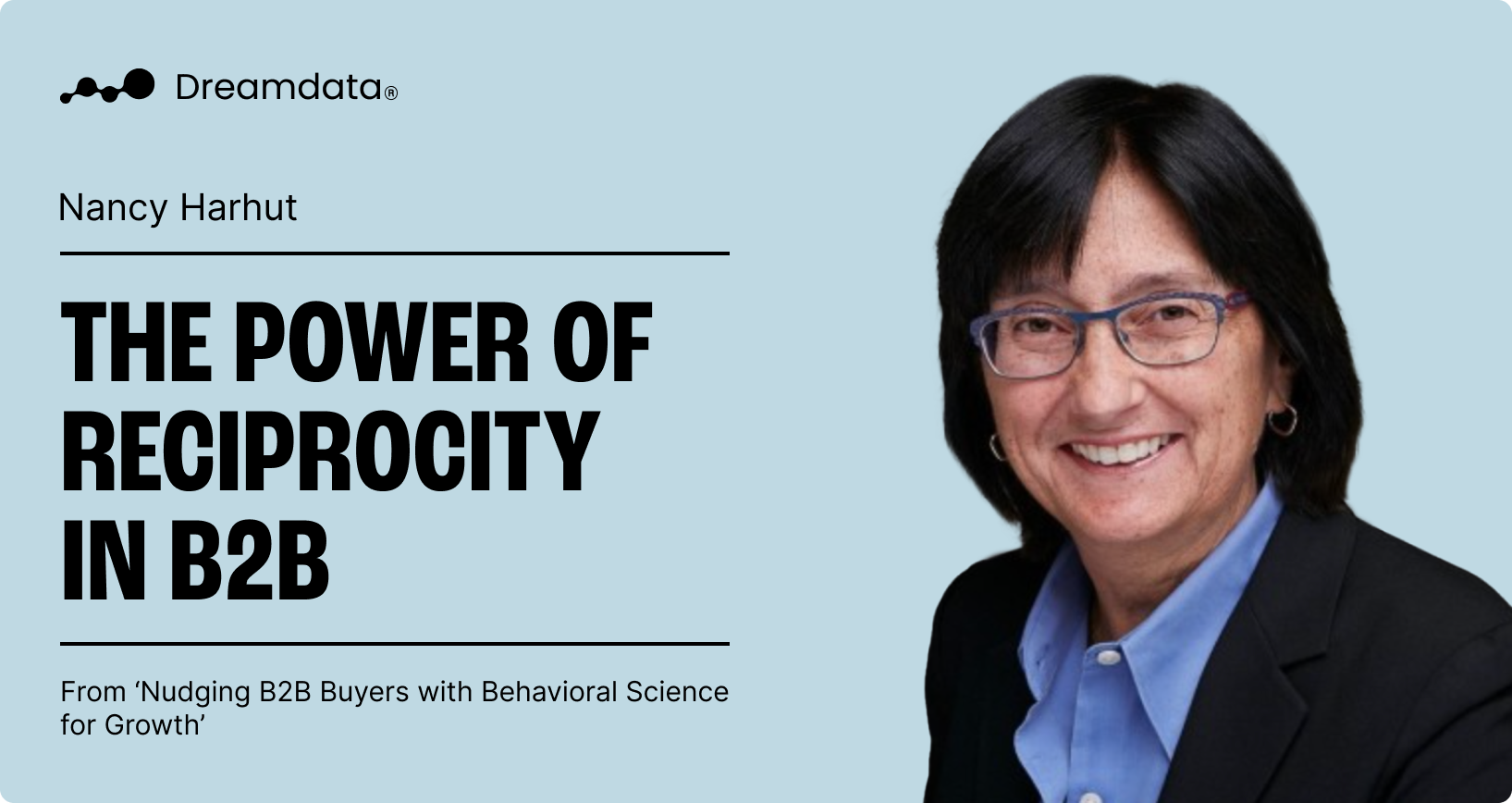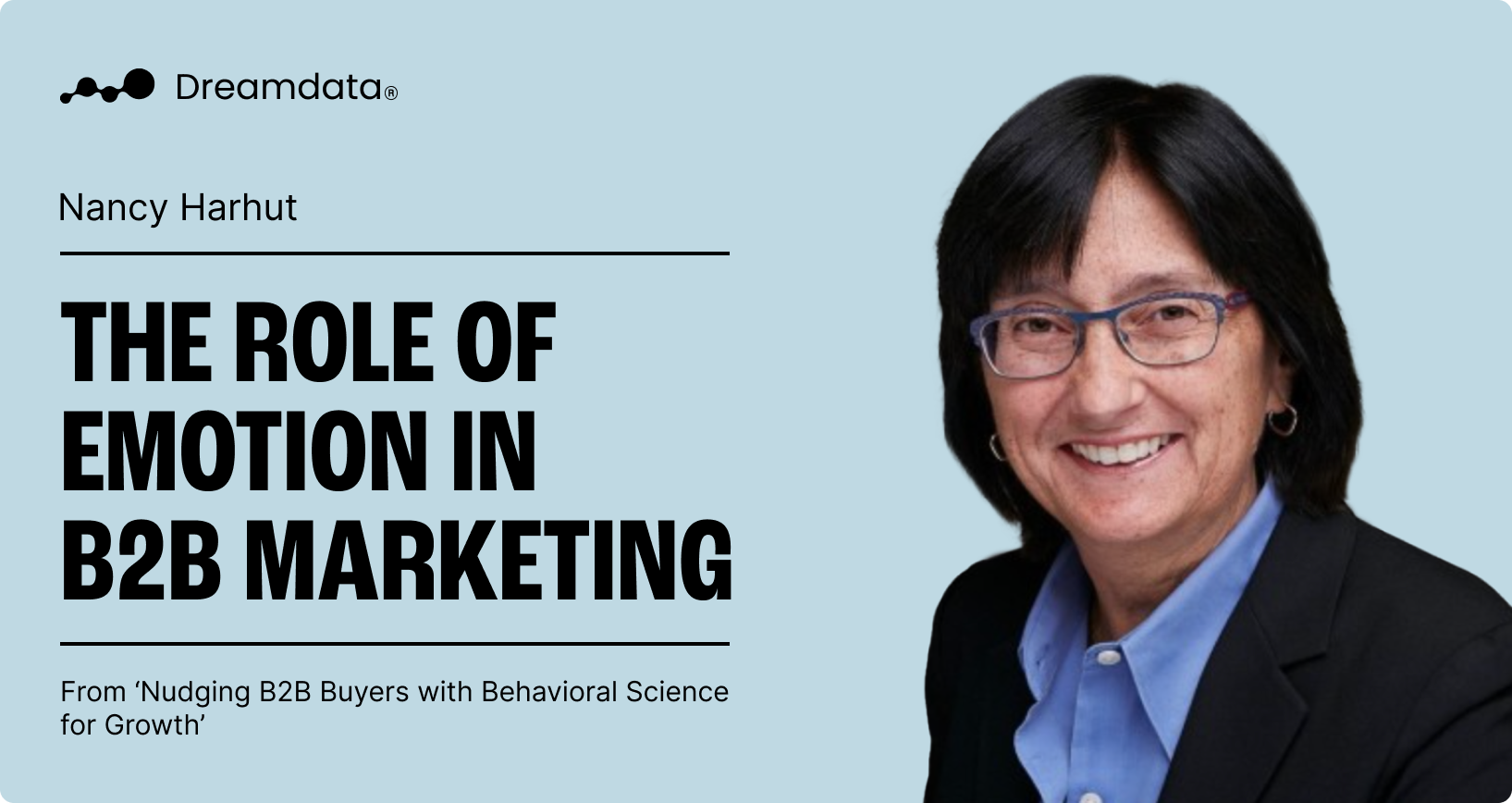Nudging B2B Buyers with Behavioral Science for Growth
Most B2B marketers operate under the assumption that buyers make decisions based purely on facts, features, and financial returns.
However, behavioral science reveals this view is often incomplete.
Understanding these psychological factors, according to expert Nancy Harhut, is crucial for creating more effective B2B marketing and driving growth.
Nancy, the author of Using Behavioral Science in Marketing and co-founder of HBT Marketing, shared her insights during a recent appearance on the Attributed Podcast.
She argues that using science to recognize how people process information and make choices allows marketers to connect more powerfully with their audience.
Keep reading to find out how to do this yourself, or listen to the conversation here.
Why B2B decisions aren't always rational
We like to believe our choices, especially professional ones, are the result of careful consideration, and marketers often build strategies based on this belief.
Yet, Nancy points out that behavioral science shows a different picture.
Very often we’re not making these well-thought-out, well-considered decisions… We're cruising along on autopilot.
This is because our brains naturally seek efficiency, relying on established mental shortcuts and automatic responses to navigate daily complexities and conserve energy.
Behavioral science studies these processes to understand decision-making. For marketers, understanding and adapting to these patterns increases the likelihood that people do what we want them to do.
This involves using subtle "nudges" or prompts grounded in psychological principles to gently guide buyers toward actions like engaging with content, requesting a demo, or making a purchase.
Behavioral Science tactics for B2B growth
Nancy detailed several practical, science-backed strategies B2B marketers can employ, often requiring shifts in perspective rather than large budgets.
Master reciprocity
A powerful principle is reciprocity, our deep-seated need to return favors.
Nancy emphasizes that this works best when the initial gift is unexpected and given without strings attached, distinguishing it from typical incentives.
If you really want reciprocity to work for you, you have to give first.
She shared a case study where sending financial advisors a personalized, framed New Yorker cartoon before asking for business led to an incredible $68 million in incremental revenue. This unexpected, thoughtful gesture created a powerful feeling of obligation, demonstrating how giving first can yield significant returns.
The science of simplicity
People prefer things that are easier to understand, easier to think about.
Buyers naturally favor messages that are easy to understand, a concept known as cognitive fluency.
Complex jargon, acronyms, and overly technical language create mental friction and reduce engagement.
Use straightforward language and break down complex ideas. This respects the audience’s time and cognitive limits, making your message more appealing and persuasive.
Use the right language to capture attention
Certain words have a proven ability to capture attention.
For instance, Nancy points to the word "because”, as research shows it acts as an automatic trigger for agreement. Simply providing a reason, even a seemingly obvious one, significantly increases compliance because it signals justification.
In practice, marketers should always explain the 'why' behind their requests using this simple conjunction.
Similarly, shifting the focus from "we" and "our" to "you" makes the message instantly more relevant and engaging, as it speaks directly to the reader's perspective and needs.
The pull of loss aversion
Psychologically, the drive to avoid loss is roughly twice as strong as the desire for gain.
People are actually twice as motivated to avoid the pain of loss as they are to achieve the pleasure of gain.
While positive framing is necessary, incorporating "loss aversion" can be more motivating.
Frame messages around what potential customers might miss out on if they don't act, or the risks of maintaining the status quo.
The isolation effect for emails
Our brains are hardwired to notice things that are different, a principle called the isolation effect.
Nancy suggests simple visual tweaks to email subject lines to leverage this. For example, using ALL CAPS for just one or two key words can increase open rates by around 21%.
Similarly, enclosing a phrase in [brackets] or (parentheses) has been shown to lift opens by about 28%. Starting the subject line with a numeral, rather than spelling out the number, can provide a 16% boost. Even strategic use of relevant emojis, like a calendar icon or an hourglass to denote urgency, can increase opens by up to 28%, making your email distinct from the rest.
Navigating the B2B buying committee with Behavioral Science
Selling in B2B often involves convincing a group, not an individual. With potentially six or more stakeholders involved, understanding group dynamics and individual motivations is key.
Different roles within the buying committee have different concerns. The end-user might worry about ease of use, while the finance lead scrutinizes the cost, and the executive sponsor considers strategic impact.
Anticipate objections, gathering them by talking to sales teams who handle objections daily, consulting customer service reps who field user issues, and monitoring online discussions and social media to gauge market sentiment and common concerns.
After identifying barriers, specific behavioral tactics can effectively address them. Employing social proof, authority markers, and strategic framing helps overcome concerns such as risk or unfamiliarity with new solutions, thereby building credibility and confidence.
Tap into authenticity and emotion
As automation and AI play larger and larger roles in marketing, genuine human connection becomes a vital differentiator.
Nancy encourages marketers to leverage authenticity by sharing real, relatable stories, perhaps about the company's founding or a customer's journey to success.
Research suggests emotional campaigns in B2B can drive significantly higher business results, so create authentic stories, infused with genuine detail and feeling, that connect in ways generic content cannot.
Common pitfalls of putting Behavioral Science into practice
Applying behavioral science effectively requires diligence and awareness of potential missteps.
What resonates with one audience segment might not work for another, so avoid trying a tactic only once and abandoning it if results aren't immediately dramatic.
Continuous, small-scale testing helps refine the approach and uncover what works best in a specific context. Even minor adjustments, like adding a single word, can sometimes lead to significant improvements, underscoring the value of experimentation.
It's also possible to inadvertently misuse behavioral science principles. Nancy points out common errors such as outright rejecting behavioral science as unsuitable for the B2B sphere.
This also includes employing "negative social proof", for example, stating, "too many businesses delay necessary upgrades". This phrasing might accidentally normalize the undesirable behavior by highlighting its prevalence, rather than encouraging change.
Conclusion
Nancy offers a compelling case for integrating behavioral science into B2B marketing strategy.
By acknowledging that buyers are humans first, driven by emotions, biases, and cognitive shortcuts, B2B marketers can create more effective, resonant, and ultimately more successful campaigns.
This requires looking beyond the spreadsheet, understanding the underlying psychology of choice, and applying principles like reciprocity, loss aversion, and social proof with care and consistent testing.
About the speaker
Nancy Harhut is the author of the acclaimed book Using Behavioral Science in Marketing and serves as the Co-founder and Chief Creative Officer of HBT Marketing. Nancy focuses on translating insights about human decision-making into practical, actionable tactics that help businesses increase engagement, response rates, and ultimately, drive growth.








